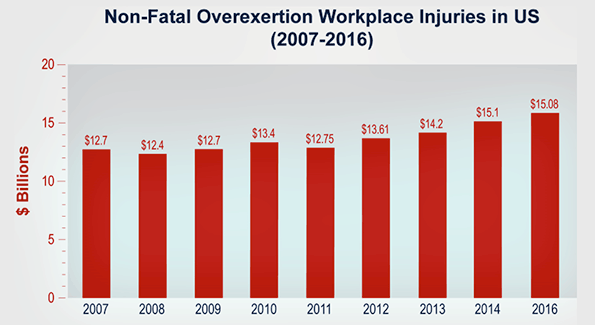Integrating ergonomics into a near-miss program involves identifying musculoskeletal disorder risk factors and empowering employees.

Follow Us
am a cautious father of a very adventurous two-year-old daughter. Every time my back is turned or I lose sight of her, there is a potential for trouble. That’s unplanned trouble of course, because my wife and I have done everything possible to try and baby proof our house, to no avail. And now that the weather is inviting us outside, there is an entirely different set of options for trouble – park visits, sticks and stones, pavement in general. I am talking about the bumps, bruises and scrapes we all endured as youngsters, but nonetheless, the idea of a “near miss” is one that I am comfortable discussing.
As a life-long ergonomist and not a trained safety professional, I have, on more than one occasion, ignored discussions regarding near misses because I dismissed them purely as a safety concept with no relationship to the field of ergonomics…or so I thought. With so much focus now on engaging our workforce through behavior-based safety and participatory ergonomics, I believe that we can (and should) make a connection between how industry addresses near misses in relation to unsafe conditions and how industry can address near misses from an ergonomics perspective.
Defining a Near Miss
The concept of near miss from an ergonomics perspective demonstrably is different than the concept from a safety perspective. The primary difference is that the likelihood and severity of the outcome vary based on the employee. Take a near-miss incident with a box cutter, for example.
The outcome of a box cutter incident is going to be the exact same from employee to employee: skin laceration. With musculoskeletal disorder (MSD) risk, however, it’s a different story, because with upper-extremity issues, there may be a variety of different outcomes. For example, poor workstation design could lead to a wrist injury or elbow injury or shoulder injury. Because employees tend to compensate for a sore body part by stressing another, the variability in the outcome of an ergonomics-related near miss must be recognized. So, with a high MSD risk task, you basically are hoping that (to continue with the box cutter example) you have employees doing the task who have really thick skin!
Ergonomics, though, is focused on preventing injuries resulting from exposure to MSD risk. These types of injuries rarely are acute (one-time occurrence); they occur from repeated exposure, which ultimately wears a joint or tissue at a rate that exceeds the body’s ability to recover. This is a major difference in perspective from most near-miss programs, which are based on observing and identifying an exposure that did not result in an injury (e.g., Whew, that was close!).
In this context, one might think that MSD injury mechanisms would be exempt from a near-miss program, but I am going to make you think about that.
When Error of Omission Equals a Near Miss
Ergonomics has long been associated with repetitive tasks and rightfully so, as high frequency is an MSD risk factor. But high frequencies of what? To simply put it, it is the frequency of awkward postures and/or high forces.
Let’s put aside awkward postures for a second and just focus on high forces. In a historical review of the most common types of injuries, it is clear that overexertion injuries are the most common (and most costly) injuries and have been on top of that list for a long time (see graphs). Think of this type of injury being caused by an employee exerting excessive forces or lifting objects that are too heavy.
Engineers of various titles (manufacturing, industrial, process) make daily decisions regarding workplace design. The resulting workstations and tasks often are designed with the potential for overexertion issues. Engineers aren’t mean people;, and they aren’t out to torture the operators; they didn’t plan on exposing operators to potential injury. It boils down to errors of omission or the lack of knowledge of proper ergonomics design guidelines across the organization.
So, if engineers didn’t plan on these design flaws, they clearly were unplanned, and if severe enough, they have the potential to result in an injury. Therefore, an unplanned event that could cause an injury makes the case that the presence of MSD risk factors inherently is a near miss.
We see examples of this all the time during our workplace observations in production, manufacturing, warehousing and delivery activities. Consider these common unplanned nuances we experience such as:
- The presence of non-standard work activities. “I usually don’t move these heavy boxes, but I am just helping the guy working next to me.”
- A power tool out of specification that causes increased vibration that is not reported to maintenance
- Manual rework due to a quality issue
- Manual work resulting from equipment failure.
These examples are instances in time, and the only way to capture these as potential issues is to educate the workforce in how to identify the risks and empower those employees to report the issues. These activities are the essential elements of a behavior-based, participatory program.
Near Misses in a Mature Ergonomics Process
One last example that has a different spin to it: let’s assume you have a more mature ergonomics process and you have completed quantifiable risk assessments. Consider the scenario in which a task has been assessed with a very high MSD risk score, but no one has been injured or reported discomfort yet. A valid MSD risk assessment tool correlates the presence of risk factors with the potential for injury. You can then consider this task a “ticking time bomb,” and it’s a just matter of time before someone gets hurt. I would call this an identified near miss and an opportunity to improve the workplace.
Owning and Executing
It is integral to a successful process to empower the workforce to identify issues and be a part of the solution. We know that everyone in an organization owns and executes the best safety and ergonomics processes. Only having one or a handful of people doing safety or ergonomics is a surefire way to fail.
I will leave you with three keys to success for integrating ergonomics into your near-miss program:
- Involve employees and supervisors, stressing the use of observation-based, qualitative screening/assessment tools, which enable them to identify and report potential MSD risk exposures.
- Empower employees to identify potential issues and be a part of the solution. This is done through a well-structured ergonomics process and follow-through on ideas.
- Provide engineers with appropriate ergonomics design guidelines to ensure ergonomics near misses are avoided as often as possible.





